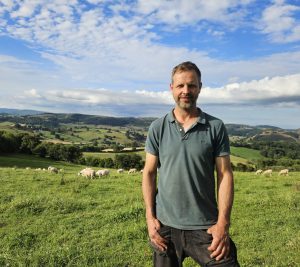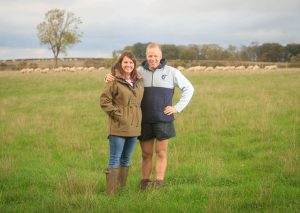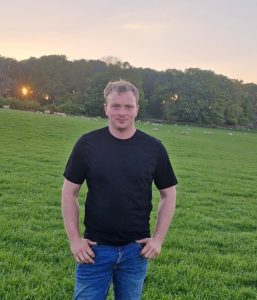with thanks to Rob Hutchings, North Molton, Devon, farming in partnership with his wife, Rachel and in-laws David and Annette Bray
Rob Hutchings was among those sheep producers seeking to future proof the family’s sheep farming enterprise. “Given the opportunity to take over from my in-laws, David and Annette Bray, we needed to farm a ewe requiring significantly less concentrate and less labour and be capable of building a closed flock of up to 1,000 ewes, a critical mass for myself to manage, apart from busy periods. Severn years on and we’re really pleased we’ve chosen Innovis genetics, it’s now on to the next challenge – improving grassland management,” he says.
“Overall, we’ve been able to achieve our flock objectives, reduce inputs and maximise output per ewe from forage by fine tuning to see what suits us best on our grassland unit and we’ve found the answer in Aberfield cross Romney ewes crossed to the Abermax for finished lamb production.

“We’ve spent the last five years grading up a traditional Whiteface Welsh Mule flock to the Aberfield cross having found a ewe that can look after herself. We are continuing to lamb indoors in March mainly because of the elements but would have no issues lambing outdoors if the weather was guaranteed, however our Aberfield crosses have enabled us to significantly reduce concentrate use at lambing time.
“The flock is scanning an average 185-190% – just about right. Lambing is pretty much done in the three weeks with very little returns. We’ve also seen a massive reduction in the amount of time spent dealing with lambs that hadn’t sucked with regards to poor teat placement that we found with the Welsh Mules. David helps out with lambing and also through the year when an extra pair of hands are needed, and he still can’t believe just how little intervention is now required.
The Innovis genetics have been selected for narrow shoulders and subsequent ease of lambing, and lambs are lively and soon up…
“The Innovis genetics have been selected for narrow shoulders and subsequent ease of lambing, and lambs are lively and soon up – that’s one of the biggest differences, and nowadays our ewes no longer have big fat teats, we very rarely find a new born lamb that hasn’t sucked.”
He continues: “We’re also getting better quality lambs; the ewes are rearing more than their body weight at 16-week weaning and 80% of the crop is away within six months. Nowadays lambs are averaging 20.5kg, KO 46% and grading within the R3L backet including a good percentage of U grades.”
Rob says eight years ago, when he was becoming a lot more involved in the farm’s decision making, the quest was on to become more efficient if it was to remain profitable. “We began by focusing on the genetics. We had started talking to Innovis at NSA events and heard more about the company’s breeds by word of mouth and the fact they had large populations of sheep farmed commercially and tried and tested in different systems.
“We agreed to initially invest in a Primera meat sire before we moved on to the Abermax and eventually the maternal Aberfield. I’m always a bit nervous about introducing something new or convincing someone else, however David stood back, he was happy for my proposed changes and he can now see the benefits.
Those EBV figures are more important to me than looks.
“A big bonus was the fact Innovis genetics are properly performance recorded so Innovis can accurately predict how the sheep will breed. Those EBV figures are more important to me than looks. We select the Abermax for growth and muscle, and the Aberfield – our future flock, for ease of lambing and motherability. We also keep an eye on mature weight – we are breeding a smaller ewe, one that’s easier to manage and keep; we found the Welsh Mules were getting on the large side and it was difficult to keep condition on them in tough times.”
In contrast, the Aberfield crosses are maintaining themselves in an average BCS 3.00 throughout the year, he says. “The same applies to both the Abermax and Aberfield rams – we are introducing them in a ratio of one to 90 and they’re coming out of the field just as fit as they went in. We’re also finding they are working for an average five years – that’s one to two more years than the Texel rams, similarly we’re expecting five lamb crops from the ewes.”
He adds: “Having sorted the genetics, we’re continuing to fine tune the business and my next goal is to improve our grassland management. We’re planning to introduce rotational grazing, it’s another big step towards improved efficiency and we’re already to go having invested in the posts and wire to split up the paddocks and start to realise Innovis genetics’ potential – what they are bred and reared to do from grazed grass.”



